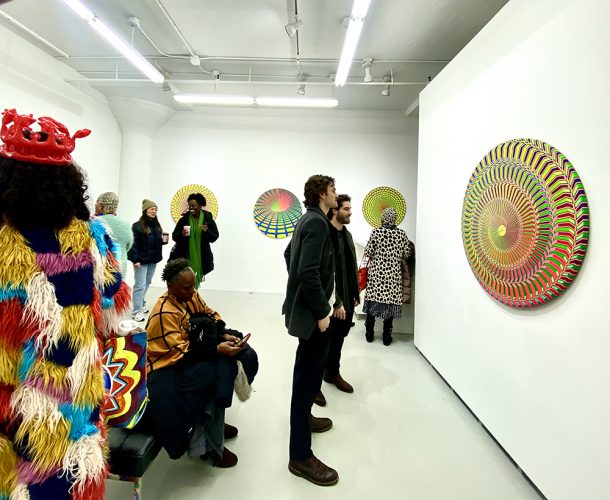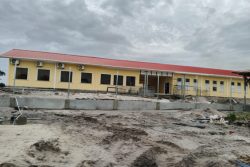 As Guyanese at home and abroad awaited Referendum Day in neighbouring Venezuela in varying states of preparedness, concern, and anxiety, Guyana-born New York City-based artist Carl F Anderson (b. 1964) awaited – no doubt with excitement – the opening of his first solo exhibition under gallery representation since migrating to the United States in the late 2000s.
As Guyanese at home and abroad awaited Referendum Day in neighbouring Venezuela in varying states of preparedness, concern, and anxiety, Guyana-born New York City-based artist Carl F Anderson (b. 1964) awaited – no doubt with excitement – the opening of his first solo exhibition under gallery representation since migrating to the United States in the late 2000s.
Eye of the Storm: Circulos Vibrante at the David Richard Gallery, New York, NY opened November 29th and debuts Anderson’s stunning new work comprising ten “circular paintings of optically active compositions.” These circular works are formalist explorations of colour and geometric shapes within deft plays with optical illusion. They, therefore, bear little resemblance to the works by Anderson last seen in Guyana in 2008 during CARIFESTA X. Then the works were prismatically colourful and unmistakably and largely figurative. Now, the works within “Eye of the Storm” are a return to his earlier interest in abstraction and he further grounds his approach in techniques of Op (Optical) Art as he uses acrylic and thread on canvas over wood support. Anderson’s meticulously painted roundels vary in diameter from 21 inches to 43 inches. These new works are from 2022 and 2023 and extend Anderson’s Spaceship Series painted in 1986 and 1990. Two paintings from this early series are in the Guyana National Collection.

Op Art! While abstraction has a long history among Guyanese artists, Op Art – a movement within – does not. Anderson is perhaps Guyana’s only artist who attempts to engage with it. While the 1960s movement may have significant contemporary artists internationally whose canvases are treated in a manner to befuddle the eye in ways that are characteristic of Op Art, Anderson’s engagement is both very effective and individual. Thus, while the ‘death of painting’ has been announced and the announcement has been declared premature through the efforts of some painters, and while currently painting’s relevance is being reasserted with a surge in figurative painting, it can be claimed that Op Art has, in Anderson, gained another cutting edge technically proficient painter to help it along in its visual shouts of relevance within paintings larger self-assertions.
According to the David Richard Gallery’s press release, “Anderson has combined his take on the use of swirling lines, hard edge geometric shapes, radiating lines, patterns, rectilinear and curvilinear forms combined with high contrast and high-keyed color combinations, including fluorescent and glow in the dark pigments that make the compositions pulse and vibrate, creating illusions of dimensional space and spinning motion. These paintings, with their various pigments, challenge the viewer’s visual perception and are optically active in natural light or under black light with an added benefit of an afterglow when the lights are switched off.”
According to Anderson, “I was introduced to Vasarely’s work [in] 1984 in Venezuela and also Bridget Riley and Soto and Cruz-Diez […].” Asked to elaborate, Anderson noted, “[…] I came across Victor Vasarely’s artworks and his colour series and illusions influenced me a great lot. […] Then I saw the Venezuelan artists’ works and my development was [accelerated] in its totality. I did not see physical pieces of Vasarely’s work in Maturin at the time – only in the history books. Then years after, I went to Caracas and I saw works of Soto and others in the museum. I think I saw one or two physical pieces in the museum in Caracas of Vasarely’s work.” Hungarian-French artist, Victor Vasarely (1906 -1997) is considered the “grandfather” of Op Art. Meanwhile, Venezuelan Carlos Cruz-Diez (1923 -2019) and Jesús Rafael Soto (1923 -2005) can be considered pioneers and proponents of the movement respectively.
Anderson is a former student of the E R Burrowes School of Art, Georgetown which was founded in 1975. His mother, recognising his talent, enrolled him in the recently established school at the age of 14. However, Anderson found his interests at odds with the school’s course of study and eventually left. This is not surprising as the student exhibited a precocious talent. Eventually, in 1983, Anderson made a short visit to Venezuela for a few months. Drawn by the possibilities to develop as an artist, he returned in 1984 and remained until 1996. While based in Maturin, Venezuela, Anderson participated in several group shows and hosted his first and second solo exhibitions. In 1996 he hosted his third solo exhibition at the Guyana Embassy in Caracas, Venezuela.
Anderson’s exhibition credits are extensive. Anderson’s work has been exhibited across the globe in unexpected places. These include participation in a 1999 exhibition at the National Museum of Modern Art, Cairo, Egypt, and the 2001 Malta International Art Biennale which was taken to Greece, France, and Malta. Since migrating to the United States, Anderson has participated in several group shows including in Timehi Traditions at the Kinkelaba Gallery NY organised by Guyana-born artist, writer, and curator Carl Hazlewood in 2013. Significantly in 2019, Anderson showed work at the 8th Beijing International Art Biennale in China. In addition to the mostly New York-based group exhibitions, Anderson has also hosted solo exhibitions including a twenty-five piece display of varied strands of work (including some shown in Guyana) at the Port Authority in New York in 2017.
About the current work Anderson first noted, “The colour scheme ad forms I use [is totally Op Art], to play with the mind in a happy sense and to mesmerise your senses.” Later he added, “These newest circular paintings are totally different and when the lights are off [they] become of a different experience and that experience signifies the galaxy beyond our earth [our] planet.” Carl F Anderson’s first solo exhibition with the David Richard Gallery, New York, NY Eye of the Storm: Circulos Vibrante closes on December 22, 2023.









